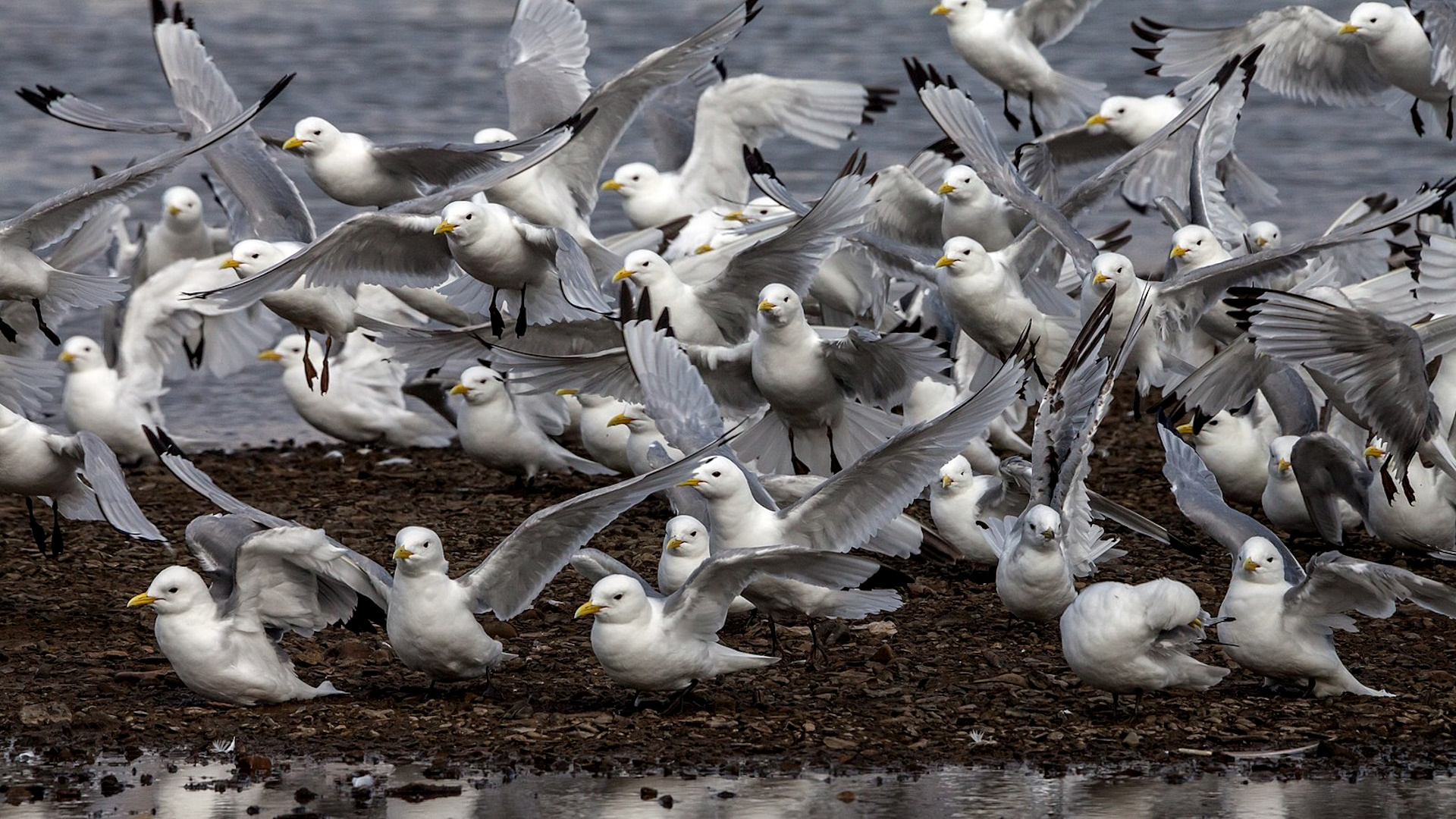
Global Extent of Bird Armageddon
Avian Flu or Radiation?
by Arthur Firstenberg, Cellular Phone Taskforce
October 17, 2023

Anders Brunstad alerted me to the installation of one of the most powerful radar stations in the world on the Varanger Peninsula in Finnmark, Norway just before tens of thousands of birds fell dead all over the peninsula. The southern and eastern coasts of the peninsula also have 4G+ and, increasingly, 5G service, added recently.
At Ekkerøy Nature Reserve, on the southern coast of the peninsula, at least 15,000 endangered kittiwakes died at the end of July and beginning of August 2023. They nest there in the summer on high cliffs where they are directly in the line of fire of the radar, which is 50 kilometers away. The restaurant at Ekkerøy was forced to close for the summer because it was “raining down” dead birds. The total population of these seabirds in Norway was only about 50,000. Dead terns and other kinds of gulls have also been collected. Half of the cranes at Ekkerøy have died.

The radar, called Globus III, was built by the United States on the island of Vardøya in Vardø, the easternmost city in Norway, which is across a bay from northern Russia. It appears to be part of a civil defense network called the Space Fence.
Details about this site have been kept secret, but I found a Request for Information published on February 22, 2022 on the U.S. government’s website, SAM.gov. It states:
“This system is a one-of-a kind design which will be fielded in 2023. The program is a bi-national, collaborative specialized collection system. The GLOBUS program is a dual band ground-based radar system consisting of an S-band solid state phased array, an X-band dish antenna, an Integrated System Controller (ISC), and a Mission Communications Suite (MCS) hosted at an Outside Continental United States (OCONUS) location.”

Other Space Fence radars are located on Kwajalein Island in the Marshall Islands, and in Western Australia. These S-band (2 GHz to 4GHz) phased array radars each have 36,000 transmitting antennas, a peak power of 2.7 MW and, when focused into a narrow beam that scans the sky in all directions, a peak effective radiated power of several billion watts.
The conflagration is not confined to Finnmark, or to Norway. Last summer I reported on mass deaths of nesting seabirds in locations near new antennas in the Netherlands and France (Birds on Texel Island; Sea Birds’ Last Refuges). This summer the situation is immensely worse. The continued proliferation around the world of 4G and 5G cell towers and antennas, as well as offshore wind farms, has killed millions of wild birds on five continents, together with foxes, skunks, raccoons, fishers, badgers, martens, black bears, grizzly bears, bobcats, lynx, mountain lions, wild boar, otters, Virginia opossums, seals, penguins, and other animals.
Last year, 40% of the Dalmatian pelicans nesting in Greece died, along with 20% of those in Romania, and large numbers in Montenegro and Albania. By May 2023, more than 50,000 dead wild birds of all kinds had been reported in the United Kingdom, 40,000 in eastern Canada, and tens of thousands in the United States. By July 31, 2023, China was reporting 5,100 dead birds in Tibet. Reports of mortality have come from every state in the United States, across 129 species of birds. Huge numbers of bald eagles have died. Just in November and December 2022, more than 50,000 seabirds died along the coast of Peru, including 16,890 Peruvian pelicans and 4,324 brown boobies, both endangered in Peru. In Chile, as of January 1, 2023, perhaps 10,000 seabirds had died, including pelicans, kelp gulls, Belcher’s gulls, grey gulls, guanay cormorants, Peruvian boobies, elegant terns, and turkey vultures.
On May 9, 2023, the Chilean government reported the deaths of 27,977 seabirds, and on July 21, 2023, the Peruvian government reported the deaths of 519,541 seabirds. These represented birds of 65 species. In addition, Chile reported the deaths of 2,517 Humboldt penguins, 460 Magellanic penguins, 16,856 sea lions, and smaller numbers of dolphins, porpoises, otters and other kinds of seals, while Peru reported the deaths of 9,314 sea lions and 100 other sea mammals. According to a report by the OFFLU, a global network of expertise on animal influenza, Chile has lost at least 13% of its Humboldt penguins, Peru has lost at least 36% of its Peruvian pelicans, and Chile and Peru together have lost at least 9% of their sea lions.
Ornithologists are all blaming this catastrophe on avian influenza, in spite of the fact that most of the dead birds are testing negative for any influenza virus, and the ones that test positive have all different variants of the virus so could not be transmitting it to one another, let alone to bears and penguins. For example, 233 dead birds were examined for flu virus by the Norwegian Veterinary Institute between August 14 and October 1, 2023. They found highly pathogenic H5N1 virus in 8 birds, highly pathogenic H5N5 in 2 birds, highly pathogenic H5Nx (other subtypes) in 2 birds, low pathogenic H5Nx in 6 birds, “other Influenza A virus” in 8 birds, and no virus at all in 207 birds.
Yet the United States is already stockpiling a vaccine against H5N1 in case it spreads to human beings and causes a pandemic.
The disappearance of bugs has also been in the news. Dr. Norman Leppla, a professor of entomology at the University of Florida, said that state’s lovebug infestation has completely vanished. They used to come in massive numbers in the spring and fall around May and September with a little variation depending on if you are in the northern or southern part of the state. “It’s not subtle, they’re really not here this season,” he said in an interview published October 5, 2023. But no one is blaming that on “avian influenza.”
Wind farms are also devastating birds, as documented by German scientists in an article published in Nature on April 13, 2023. They found that populations of red-throated loons plummeted in the North Sea after five clusters of offshore wind farms were built there between 2010 and 2014. Their populations declined by an average of 94% within 1 kilometer of a wind farm and by 52% within 10 kilometers, with some population reduction at distances up to 24 kilometers.
Wind farms are also killing whales. At least 32 whales have washed up dead on the U.S. east coast in recent months, prompting a group of New Jersey legislators to call for an immediate moratorium on offshore wind farms in the area.
Communities that are waking up
They learned this from a field survey by scientists at C.V. Raman University that was conducted in 2017 of birds in the vicinity of the 9 cell towers in Bijapur district. Reviewing 113 studies on the ecological effects of RF radiation, the authors wrote:
“When birds are exposed to weak electromagnetic fields, they disorient and fly in all directions, which harm their natural navigational abilities. A large number of birds like pigeons, sparrows, swans are getting lost due to interference from the ‘unseen enemy’, i.e. mobile tower. It has also been noted of late that animals used near mobile towers are prone to various dangers and threats to life including still births, spontaneous abortions, birth deformities, behavioral problems and general decline on overall health. Electromagnetic pollution is a possible cause for deformations and decline of some amphibian populations too. Apart from birds and animals, electromagnetic radiation emanating from cell towers can also affect vegetable, crop and plants in its vicinity.”
They visited the areas where each cell tower was located for 2 to 3 hours in the morning and 2 to 3 hours in the evening, every day for 6 months, and counted birds — peacocks, wild ducks, crows, parrots, cuckoos, sparrows, wild pigeons, eagles, and woodpeckers. There were far fewer of every kind of bird in 2017 than there had been in a survey conducted in 2006 before the towers were erected.
It bears repeating, yet again, that influenza, whether in people, animals, or birds, is not caused by a virus and has never been demonstrated to be a contagious disease. In 1918, at the height of the Spanish influenza, attempts by medical teams in Boston and San Francisco to demonstrate the contagious nature of the flu met with complete and resounding failure. Such experiments in humans were published in the Journal of the American Medical Association, the Boston Medical and Surgical Journal, and Public Health Reports. Such experiments in horses were published in Veterinary Journal. Chapters 7, 8 and 9 of my book, The Invisible Rainbow: A History of Electricity and Life, are devoted to a complete, detailed examination of the history and science of influenza. Chapter 16, the longest chapter in the book, is devoted in part to the effects of electromagnetic radiation on birds. Some diseases are caused by viruses, but influenza is not one of them. I suggest once again that all bird conservation organizations should acquire my book and read it carefully.
Connect with Arthur Firstenberg
Cover image credit: AWeith

Truth Comes to Light highlights writers and video creators who ask the difficult questions while sharing their unique insights and visions.
Everything posted on this site is done in the spirit of conversation. Please do your own research and trust yourself when reading and giving consideration to anything that appears here or anywhere else.










